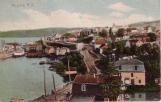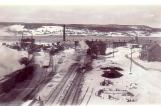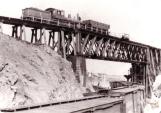1
Mulgrave looking south up Main St.The train ferry dock is on the left.1905
Mulgrave, Guysborough County, Nova Scotia, Canada

2
RAILROAD ARRIVES IN MULGRAVE IN 1880The Strait of Canso had only been settled for one hundred years when the railroad arrived from New Glasgow as far as Mulgrave on the mainland side of the Strait of Canso in 1880. This brought goods and services to the area as well as jobs.
Besides those working on the railroad, it created jobs to those who would continue providing ferrying services back and forth across the Strait of Canso to Cape Breton Island.
4
RAILWAY ON CAPE BRETON ISLAND BY 1890 - The Intercolonial railway was built between Point Tupper and Sydney on Cape Breton Island by 1890. There was a train ferry which operated across the Strait of Canso from Mulgrave to Point Tupper. The Point Tupper rail yard was where all trains going to or from Cape Breton Island landed. This provided not only goods and transportation but also jobs for those in the area.For many years, the railroad would drive the economy of the Strait of Canso communities.
5
Scotia train ferry crossing from Point Tupper to Mulgrave1910
Strait of Canso, Nova Scotia, Canada

6
THE SCOTIA TRAIN FERRIES - By 1893, the S.S. Mulgrave was being used to move nine passenger trains loaded on a scow to be towed across the Strait of Canso. The Scotia was a self propelled, coal fired vessel which was built in England and put into service between Mulgrave and Point Tupper in 1902. By 1915, the Scotia II was put into service as well.The Scotia II was 300 feet long with a capacity of eighteen 45 foot long rail cars - six each on three tracks. The Scotia II helped ease the bottleneck at the Strait of Canso for awhile.
8
RAILROAD FOR INVERNESS COUNTY - The western part of Cape Breton Island was still unserviced by rail at this time. Donald Mann and William MacKenzie, partners from Ontario, saw a business opportunity. They opened the Inverness Railway and Coal company (originally called the Inverness and Richmond Railway) line between their Coal Pier in Port Hastings and their coal mine in Broad Cove, Inverness County on June 15th, 1901. By December, they had completed the line to Point Tupper and the connection with the Sydney line.10
COAL PIER -The Inverness Railway and Coal Company's Coal Pier had tracks on top. When the bottom door of the coal cars were opened, the coal fell down into the pier. The larger pier, about 64 feet above water level, allowed carrier ships to receive the coal by one of 20 angled chutes which loaded by gravity. Ten to 12 thousand tons of coal could be loaded per day, equalling two or three ships per week. The coal pier was built to the south of where the Canso Causeway would later be constructed. Coal from Inverness was also taken to the mainland over the rail ferries and shipped within the province.11
Inverness Railway and Coal Company Shipping Pier looking north west.1910
Port Hastings, Inverness County, Nova Scotia, Canada

12
SELF SUFFICIENT COMMUNITY - The community of Port Hastings, formerly called Plaister Cove for its gypsum deposits, was a bustling community in the early 1900's. There were many stores, a hotel, telegraph and post offices and other businesses to provide for residents in the outlying communities.The communities in the district provided most of the 60 workers needed for the Coal Pier and men to work on the railroad.
The railroad station was a busy spot in the village as were the wharves along the shore.
13
Inverness Railway and Coal Company Water tower at Creignish1910
Creignish, Inverness County, Nova Scotia, Canada

14
The July 11th, 1904 Time Table for the Inverness Railway and Coal Company train indicates it left Inverness every morning at 7:30 am. and had thirteen stops before reaching Point Tupper at 11:08 am.They were at
07:47 - Strathlorne
08:10 - Black River
08:15 - Glendyre
08.25 - Mabou
08:55 - Glencoe
09:10 - Port Hood
09:32 - Catherine's Pond
09:45 - Judique
10.03 - Craigmore
10:18 - Creignish
10:30 - Troy
10:40 - Port Hastings
11:03 - Port Hawkesbury
11:08 - Point Tupper


